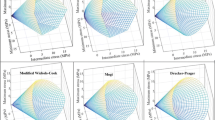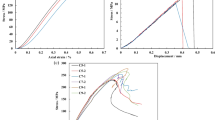Abstract
A new methodology for the calibration of bond microparameters in rocks represented by a package of joined random spherical particles in the discrete element method (DEM) framework is presented. Typically, calibration is achieved through a trial-and-error procedure using several DEM simulations of uniaxial compressive tests (UCTs). The bond calibration model (BCM) does not need a time-dependent UCT-DEM simulation to establish the relation between the microproperties of the bond and the macroproperties of the rock specimen. The BCM uses matrices to describe the interaction forces exerted by bonds and, by means of an assembly process similar to the finite element method, it can describe the complex network of bonds, enabling the model to capture small variations in particle size and bond distribution as demonstrated in this work. In this work, the BCM is presented and compared with UCT simulations performed using Esys Particle software. Multiple simulations are done with constant bond properties and different particle size ratios (\(D_{MAX}/D_{MIN})\) that cause small variations in the specimen’s Young’s modulus; these variations are well captured by the BCM with an error of <10%.







Similar content being viewed by others
Notes
Particle 3 is in contact with the plate when \(c=0\).
References
Chandrupatla, T.R., Belegundu, A.D., Ramesh, T., Ray, C.: Introduction to Finite Elements in Engineering. Prentice Hall, Upper Saddle River (1997)
Cho, N., Martin, C., Sego, D.: A clumped particle model for rock. Int. J. Rock Mech. Min. Sci. 44(7), 997–1010 (2007). doi:10.1016/j.ijrmms.2007.02.002
Cundall, P.A., Strack, O.D.L.: A discrete numerical model for granular assemblies. Gotechnique 29(1), 47–65 (1979). doi:10.1680/geot.1979.29.1.47
Estay, D.A., Chiang, L.E.: Discrete crack model for simulating rock comminution processes with the discrete element method. Int. J. Rock Mech. Min. Sci. 60, 125–133 (2013). doi:10.1016/j.ijrmms.2012.12.041
Munjiza, D.A.A.: The Combined Finite-Discrete Element Method. Wiley, Chichester (2004)
Potapov, A., J.H., H., Song, M., Pate, W.: A DEMPBM fast breakage model for simulation of comminution processes. In: Proceedings of the MEI Discrete Element Methods (DEM) 07 conference (2007)
Potapov, A.V., Campbell, C.S., Hopkins, M.A.: A two-dimensional dynamic simulation of solid fracture part II: examples. Int. J. Mod. Phys. C 6, 399–425 (1995). doi:10.1142/S0129183195000289
Potapov, A.V., Hopkins, M.A., Campbell, C.S.: A two-dimensional dynamic simulation of solid fracture part I: description of the model. Int. J. Mod. Phys. C 6, 371–398 (1995). doi:10.1142/S0129183195000277
Potyondy, D., Cundall, P.: A bonded-particle model for rock. Int. J. Rock Mech. Min. Sci. 41(8), 1329–1364 (2004). doi:10.1016/j.ijrmms.2004.09.011
Thornton, C.: Numerical simulations of deviatoric shear deformation of granular media. Géotechnique 50(1), 43–53 (2000)
Wang, Y., Abe, S., Latham, S., Mora, P.: Implementation of particle-scale rotation in the 3-d lattice solid model. Pure Appl. Geophys. 163(9), 1769–1785 (2006). doi:10.1007/s00024-006-0096-0
Wang, Y., Alonso-Marroquin, F.: A finite deformation method for discrete modeling: particle rotation and parameter calibration. Granul. Matter 11(5), 331–343 (2009). doi:10.1007/s10035-009-0146-2
Wang, Y., Mora, P.: Macroscopic elastic properties of regular lattices. J. Mech. Phys. Solids 56(12), 3459–3474 (2008)
Author information
Authors and Affiliations
Corresponding author
Ethics declarations
Conflict of interest
The authors declare that they have no conflict of interest.
Rights and permissions
About this article
Cite this article
Estay, D., Chacana, F., Ibarra, J. et al. Bond calibration method for Young’s modulus determination in the discrete element method framework. Granular Matter 19, 60 (2017). https://doi.org/10.1007/s10035-017-0734-5
Received:
Published:
DOI: https://doi.org/10.1007/s10035-017-0734-5




